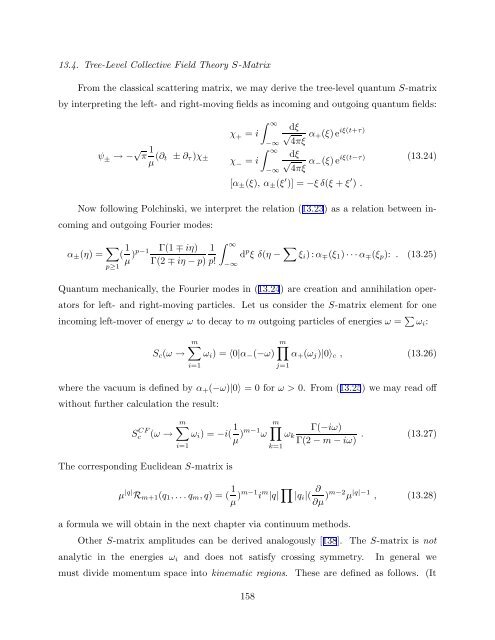arXiv:hep-th/9304011 v1 Apr 5 1993
arXiv:hep-th/9304011 v1 Apr 5 1993
arXiv:hep-th/9304011 v1 Apr 5 1993
You also want an ePaper? Increase the reach of your titles
YUMPU automatically turns print PDFs into web optimized ePapers that Google loves.
13.4. Tree-Level Collective Field Theory S-Matrix<br />
From <strong>th</strong>e classical scattering matrix, we may derive <strong>th</strong>e tree-level quantum S-matrix<br />
by interpreting <strong>th</strong>e left- and right-moving fields as incoming and outgoing quantum fields:<br />
ψ ± → − √ π 1 µ (∂ t ± ∂ τ )χ ±<br />
χ + = i<br />
χ − = i<br />
∫ ∞<br />
−∞<br />
∫ ∞<br />
−∞<br />
dξ<br />
√<br />
4πξ<br />
α + (ξ) e iξ(t+τ)<br />
dξ<br />
√<br />
4πξ<br />
α − (ξ) e iξ(t−τ)<br />
[α ± (ξ), α ± (ξ ′ )] = −ξ δ(ξ + ξ ′ ) .<br />
(13.24)<br />
Now following Polchinski, we interpret <strong>th</strong>e relation (13.23) as a relation between incoming<br />
and outgoing Fourier modes:<br />
α ± (η) = ∑ ( 1 ∫<br />
Γ(1 ∓ iη) 1 ∞<br />
µ )p−1 d p ξ δ(η − ∑ ξ i ) : α ∓ (ξ 1 ) · · · α ∓ (ξ p ): . (13.25)<br />
Γ(2 ∓ iη − p) p!<br />
p≥1<br />
−∞<br />
Quantum mechanically, <strong>th</strong>e Fourier modes in (13.24) are creation and annihilation operators<br />
for left- and right-moving particles. Let us consider <strong>th</strong>e S-matrix element for one<br />
incoming left-mover of energy ω to decay to m outgoing particles of energies ω = ∑ ω i :<br />
S c (ω →<br />
m∑<br />
m∏<br />
ω i ) = 〈0|α − (−ω) α + (ω j )|0〉 c , (13.26)<br />
i=1<br />
j=1<br />
where <strong>th</strong>e vacuum is defined by α + (−ω)|0〉 = 0 for ω > 0. From (13.25) we may read off<br />
wi<strong>th</strong>out fur<strong>th</strong>er calculation <strong>th</strong>e result:<br />
Sc<br />
CF (ω →<br />
m∑<br />
ω i ) = −i( 1 µ )m−1 ω<br />
i=1<br />
The corresponding Euclidean S-matrix is<br />
m∏<br />
k=1<br />
ω k<br />
Γ(−iω)<br />
Γ(2 − m − iω) . (13.27)<br />
µ |q| R m+1 (q 1 , . . . q m , q) = ( 1 µ )m−1 i m |q| ∏ |q i |( ∂<br />
∂µ )m−2 µ |q|−1 , (13.28)<br />
a formula we will obtain in <strong>th</strong>e next chapter via continuum me<strong>th</strong>ods.<br />
O<strong>th</strong>er S-matrix amplitudes can be derived analogously [138]. The S-matrix is not<br />
analytic in <strong>th</strong>e energies ω i and does not satisfy crossing symmetry. In general we<br />
must divide momentum space into kinematic regions. These are defined as follows. (It<br />
158
















